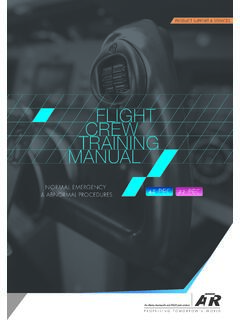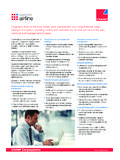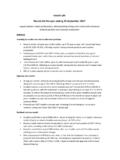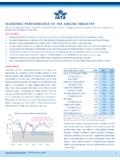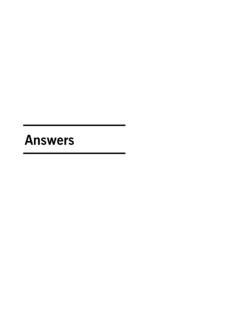Transcription of B777 Normal Procedures - Airline Pilots Forum and Resource
1 b777 Normal Procedures Last Updated 31st July 2015 Preflight Summary 1. Electrical Power Up 6. Exterior Inspection 2. Aircraft Documents 7. Preflight Procedure 3. Preliminary Preflight Procedure 8. Takeoff Performance 4. ATIS 9. Briefing 5. CDU Preflight 10. Checklist Electrical Power Up: To be done through Supplementary Procedures if required. * A file containing a list of required manuals/books to be on board needs to be checked. Latest revision file has to be updated within the past 10 days. Misc 1 Technical Log Book 2 Flight Log 3 Captain s Debrief 4 Route Manuals Areas of Responsibility - Captain as Pilot Flying or Taxiing Areas of Responsibility - First Officer as Pilot Flying or Taxiing Preliminary Preflight Procedure Captain or First Officer The Preliminary Preflight Procedure assumes that the Electrical Power Up supplementary procedure is complete. To be Done on Every Sector A An All ADIRU switch - OFF 30 seconds, then ON Verify ON BAT light and OFF light extinguished S Sector STATUS Expected messages only Oxygen pressure Hydraulic quantity E Exercise ENG Engine oil quantity To be Done After Crew Change or Maintenance Action Maintenance documents Check FLIGHT DECK ACCESS SYSTEM switch Guard closed Emergency Equipment Fire extinguisher Checked and stowed Crash axe Stowed Escape ropes Stowed Other (life vest etc) Checked and stowed Overhead Maintenance Panel Guards closed Lights extinguished CARGO TEMPERATURE selectors as needed Circuit Breakers Check Parking Brake * As Needed * Verify EICAS memo message PARKING BRAKE SET.
2 Do not assume that the parking brake will prevent airplane movement. Accumulator pressure can be insufficient. ATIS CDU Preflight Procedure - Captain and First Officer See FMC Preflight ( ) On TAKEOFF REF page, make data entries on page 2/2 before page 1/2. Exterior Inspection Preflight Procedure Captain and First Officer Note: Before performing any preflight Procedures , move the FMC selector switch to either L or R, then back to AUTO. If this cycling is inadvertently overlooked prior to preflight, it can be done in flight at any time. [Ref: Flight Crew Operation Manual Bulletin (PIA-51) for Un-commanded Autothrottle Movement During Cruise Flight] 1) PFD: FMA: Auto-throttle mode blank Roll mode TO/GA Pitch mode TO/GA AFDS status FLT DIR No flags except NO VSPD until takeoff V speeds are selected. Altitude Readings: Note down on master document (RVSM requirement).
3 2) ND: No flags except TCAS OFF 3) EICAS Screen: Absence of the following Five Messages is a clue that something has been left out during preflight: Parking Brake Autobrake APU Doors Seatbelts Sign 4) MFD: Secondary ENGINE indications STATUS - Check messages. CHECKLIST - RESET ALL COMM MANAGER SYSTEM INFO = Verify Correct Tail Number (AIMS BP V17 or >) 5) FMC RTE 2 (alternative route, different DEP / RW, or in-flight return route if required) Cost Index: As per policy. Check NAV RAD and POS REF Page to clear values if previously entered. Enter all Step Climbs from CFP Route Data: W/V and FL Temperature (starting at first waypoint after TOC). Subsequent wind data should be entered for a change greater than 10 deg or 10 knots and change in cruise level. Enter temperature changes equal to or greater than 2 deg. After execution of route, completion of initialization pages and completion of fuelling, enter the estimated ZFW to check estimated TOGW.
4 Also check the total distance & fuel remaining at destination on progress page. Cross check it against the CFP. 6) Configuration Check: If there is an incorrect configuration or response: Verify that the system controls are set correctly. Check the respective circuit breaker. Test the respective system light as required. Departure Briefing 1. Weather and Notams. 2. VHF Communication Frequencies to be used / set. 3. Push and Start up Procedures . 4. Taxi routing to the runway in use. 5. Runway Information: D Dimensions (Length, Width, Stopway) S Surface Condition L Lighting 6. Take off Procedure: Thrust Setting ( TO-2 SEL 45) Configuration ( Flaps 5) Packs ( on APU) Anti-ice ( On) Noise Abatement Procedure (if any) Thrust Reduction (1000 ft or as required) Acceleration - 2 Eng (3000 ft or as required) Acceleration 1 Eng (1000 ft or as required) 7. SID Procedure: Nav Frequencies to be used.
5 Routing and Constraints Transition Altitude MSA First Cleared Level 8. Communication Failure Procedure 9. Miscellaneous: Weather after takeoff, use of Wx radar / terrain function etc. Takeoff Briefing by Captain Capt as PF: Call out any malfunction or warning and silence the aural warning. I will call STOP or GO I will reject takeoff for any warning or condition that significantly affects the safety of the flight. Before 80 knots: Takeoff will be rejected for: Takeoff configuration warning System failure(s) Activation of the master caution system Tire failure Unusual noise or vibration Abnormally slow acceleration If a side window opens Fire or fire warning Engine failure Predictive windshear warning If the airplane is unsafe or unable to fly Between 80 knots and V1: Takeoff will be rejected for: Fire or fire warning Engine failure Predictive windshear warning If the airplane is unsafe or unable to fly After V1: Takeoff will be continued: No action will be taken below 400 feet AGL other than: > Application of TOGA.
6 > Silencing of Aural Warning. If F/O is PF the briefing will include: I will have control of the thrust levers for take off. If I call STOP , I will take over control and reject the take off. If I call GO , you will continue the take off until I say I HAVE CONTROLS . Load and Trim Sheet Max allowable difference between AZFW and EZFW is 7000 Kgs before a new trim is required. Ref: OETB 25th September 2008 Last Minute Change (LMC): [Ref: PIA Weight and Balance Booklet Page ] a) No change in CG is required if Passenger or Weight Changes (loading/off-loading) are: 4 passengers with baggage anywhere and 400 Kg load in any lower hold. Only ZFW, TOGW and Total SOULS ON BOARD figures have to be revised. b) If changes on computerized load sheet are more than those specified above, fresh load sheet is required to be prepared. c) If last minute changes on Manual load sheet are more than those specified above, follow the detailed LMC procedure (page and ).
7 ZFW and TOCG will be inserted in the FMC. FMC figures of Total Fuel, TOGW and Stab Trim will be reconfirmed. An average of TOCG & ZFWCG will be inserted in the CRUISE CG space on the PERF INIT page. If EFB performance calculating speeds are higher, they must be inserted in the FMS. Before Start Procedure F/O Do Items 1) Close all the doors and windows and make the departure announcement. 2) Set the CDU. 3) After ATC clearance, set the overhead panel (fuel and hydraulic) and turn on the beacon. 4) Check Recall. Flight Deck Door Closed and Lock CDU Display PF Takeoff Ref Page PM Legs Page Exterior Doors Closed * (make the departure announcement ) Flight Deck Windows Closed and Lock ATC Clearance To Start Engines Hydraulic Panel Set ** Fuel Panel Set ** Beacon Light Switch ON Cancel/Recall Switch Only expected alert messages should show ** * Confirm through the door synoptic ** If the tow bar is connected, do not pressurize the hydraulic systems until the nose gear steering is locked out.
8 Unwanted tow bar movement can occur. Pressurize the right system first to prevent fluid transfer between systems. ** Center tank pumps ON if there is more than 4,800 kilograms of fuel in the center tank. One or both PRESS lights may stay illuminated until after the engine start because of load shedding. ** For unexpected messages, check the DDG and decide if maintenance is needed. Captain Do Items 1) Close the window. 2) Set the CDU and MCP. 3) Ground Clearance: Nose gear steering locked out + Hydraulic Pressurization. 4) Set the stabilizer trim. CDU Display PF Takeoff Ref Page PM Legs Page MCP Set V2 LNAV VNAV Heading/Track Altitude Flight Deck Windows Closed and Lock Coordination with Ground External Power / Tug Master - As required Hydraulics Clearance to Pressurize Nose Gear Steering - Locked Out for Pushback Trim Set Pushback or Towing Procedure Captain F/O Communication with ground Parking brake as directed by ground* Timer ** After Pushback Tow bar - Verify NOT connected Nose Gear Steering Verify NOT locked out Transponder As Needed * Do not hold or turn the nose wheel tiller during pushback or towing.
9 Do not use airplane brakes to stop the airplane during pushback or towing. ** When commencing pushback CM1 will start the elapsed time function of the clock (Ref: FOM ) Engine Start Procedure Captain F/O Secondary Engine Display Announce Start Sequence Call Start ____ Engine Engine Start/Ignition Selector START Fuel Control Switch RUN Verify Oil Pressure Increase * * Auto start does not monitor oil pressure and temperature. Do the ABORTED ENGINE START checklist if there is no oil pressure indication after the EGT increases. Note: During or after engine start if there is an alert message then do the respective non- Normal checklist and check the DDG (on ground). After engine start, there is no need to check status messages. Any message that has an adverse affect on safe continuation of the flight appears as an EICAS alert message. Before Taxi Procedure A APU, Anti-ice and Area clear F Flaps and Flight Controls Check T Transponder B Briefing E EICAS and EFB L Lights Captain F/O APU OFF Engine Anti-Ice As Needed Verify Ground Equipment Clear * Verify Ground Equipment Clear * Call for Takeoff Flaps Set Takeoff Flaps Flight Controls Check ** Transponder As needed Recall Check Push Cancel/Recall Switch Recall Check EFB Airport Map Set ** EFB Airport Map Set ** Call for Before Taxi Checklist Do the Before Taxi Checklist Taxi Clearance Update changes to taxi briefing if required Exterior Lights As Required Set on captain s command * After start, captain will ensure removal of all ground connection, display of nose wheel steering bypass pin, and hand signal (R or L).
10 Taxi will be commenced after announcement of Clear my side by both Pilots and Hand signal / by pass pin sighted . ** To avoid nuisance FLIGHT CONTROLS faults, a complete cycle of the control wheel during the flight control check should be done slowly (more than approximately 6 seconds) and not combined with the check of the pitch controls. ** Not to be used as a primary navigation reference. It is designed to aid flight crew positional awareness only. Before Takeoff Procedure Engine Warm Up: Engine oil temperature must be above the bottom of the temperature scale. Run the engines for at least 3 minutes using a thrust setting normally used for taxi operations. PF PM Weather Radar and Terrain Display as required * Takeoff Briefing Update if needed Monitor Cabin Ready Message Before Entering Runway EFB Select SID Cabin Announcement EFB Select SID Call for Before Takeoff Checklist Do the Before Takeoff Checklist * In case of departure from an airport with surrounding high terrain PM will select TERRAIN on his ND.




